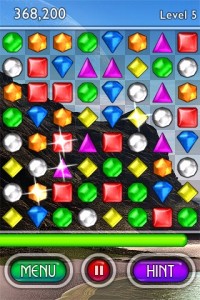by Annie | Jul 19, 2010 | Game Design
Everyone knows that designing a game is pretty simple. All you need are gameplay mechanics, basic rules, and an objective. Designing a fun game, on the other hand, is a completely different beast. A couple of weeks ago, I was tasked with creating a list of 25-50 analog game ideas in order to create an original board game from scratch within the next 6 weeks or so. The first five ideas came pretty easily, but the rest felt like pulling teeth. Sitting outside on the balcony, I tried using everything in the environment for inspiration. Car zooms by – ah, racing game. Wind blows – hmm, leaf collecting game? Twenty-eight ideas later, I had a few decent ones. Now came the hard part: choosing an idea and developing it into a full-fledged game. I spent the better part of this past weekend drawing and staring at shapes, trying to imagine strategic moves and epic analog battles. My basic idea was for a spider web game involving prey capture and natural obstacles, like wind damage. Players would build the web, trying to capture prey while thwarting their opponents. Sounds pretty simple and fun, right? Not so fast. This is where play-testing comes in. Prototype after prototype revealed new and unforeseen challenges. Here are some issues I ran across: – Pieces bunch up when trying to capture the same prey. – Pieces spread out when trying to capture different prey. – Should prey placement be random? – How should players “build” a web? – How do you show the effects of wind on a board game? After a few iterations, I stepped back from...
by Annie | Jul 16, 2010 | Game Design
Not sure if games are worthwhile? Well, according to Jane McGonigal, games have the power to transform the world, giving players the skills to solve large-scale real world problems. Don’t believe it? Take a look. She can be quite...
by Annie | Jul 16, 2010 | Game Design
Maybe it’s the blog, or my love of reading, or my three-year break from student life, but I’ve discovered a new love for writing. Instead of dreading essay assignments, I now crave them. Just today, I completed two analysis papers within the breaks between classes, and I’m already hungry for more. Now, I can’t tell you whether or not my writing is actually any good; you’ll have to be the judge of that. I think the joy I get in writing is that I have a voice, a way to communicate my unique perspectives without any interruptions from others. I can shoot out all my thoughts, put them aside, then go back later and make them sound more coherent or add more humor. Writing gives me the freedom to share my writing when I please or keep it to myself without fear of judgment. As with many industries, game design is built around clear communication. Great game designers not only come up with great ideas, but they have the intellectual prowess to communicate those ideas effectively, both verbally and on paper. You might have the most innovative idea the world’s never heard of, but if you can’t tell people about it, it may soon become someone else’s great idea. So if you’re thinking about a career in the game industry, start first with a pen and paper. Jot down ideas for characters, for different levels…heck, you could even jot down what you had for lunch. Just write. The more you write, the better you’ll get. Think of it as leveling up, in the world of...

by Annie | Jul 14, 2010 | Game Design
My dad once tried to teach me how to play the game Go when I was in kindergarten. Staying home to work on his PhD thesis, he was easily bored, and seeing as how I was the only other person in the house, I was by default the most worthy opponent. On the most basic level, Go is a game of surrounding your opponent’s pieces. In fact, the Chinese name for the game literally means “encirclement game.” Taking turns to place black or white stones on grid intersections, you work to surround your opponent’s pieces, thus capturing them and removing them from the board. Sounds pretty simple, right? Wrong. Soon after starting, you’ll realize that Go can quickly become very complex. You and your opponent are simultaneously trying to surround each other’s pieces, making for an increasingly messy situation. Strategy, skill, and planning ahead definitely come into play, or else you’ll soon find the board slowly being taken over by your opponent’s color. Similar to poker, there are expert Go players, and Go tournaments can award prizes of up to a quarter of a million dollars. Never played? The best way to learn is to play. Beware: rules are easy to grasp, but the game is difficult to master. Ready for a challenge?...

by Annie | Jul 13, 2010 | Game Design
I’ve recently rediscovered my insatiable love for Bejeweled 2. For those of you who have never played, the gameplay is quite simple. Given a grid of random jewels, you must switch adjacent jewels to create strings of 3 or more. Bonus events occur when you get 4 or 5 gems in a row. Pretty simple. Not rocket science. So why has the game been played and replayed hundreds of millions of times? What keeps people coming back to such a straightforward game? The answer lies in the psychology behind the game. While the gameplay may seem simple, the psychology behind it certainly isn’t. Here’s why: 1. Difficulty level Bejeweled may not require a PhD in pattern finding, but there is some level of skill required for the game. You have to practice in order to increase your skill in finding rows of jewels. With a learning curve in place, the player gets a sense of contributing to and earning the rewards, making them all that much more gratifying. 2. Randomness and unpredicability Sure you can control which jewels to move, but you have no power over the placement of the gems in the grid. The jewels appear in a random pattern, so gameplay is new and different each time you play. Because of this, you can’t predict the outcomes. This keeps you constantly guessing as your dopamine neurons are jumping up and down in elation, quite similar to the effect gambling has on your brain. 3. Cascading effects At certain points in the game, you might create a simple string of 3 jewels that sets off huge cascading effects,...

by Annie | Jul 11, 2010 | Game Design
Because so many VFS classes are taught by industry professionals, people still very active in the field, several classes take place in the evening. This week, I have 6:30-9:30pm classes Monday through Thursday. The upside of evening classes is that they’re not in the morning. The downside, however, is that I have to bring both lunch and dinner every day to avoid high restaurant meal bills. Thus, Joe and I just spent about 3 hours cooking dinners for the whole week – Joe as the sous chef and me as the executive chef. Pasta, rice, sausage, bacon, greens, asparagus, cauliflower, chicken, potatoes, and lots of onions and garlic. We’ve certainly done enough slicing, dicing, sauteing, and dishwashing to last us several days. Looks like it’s going to be a tasty...



